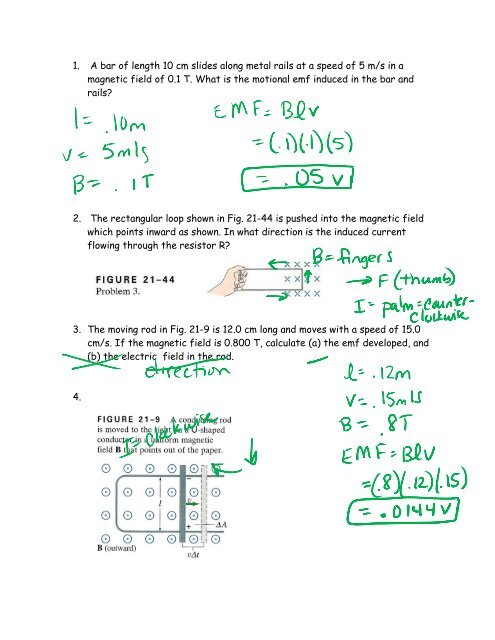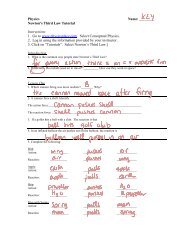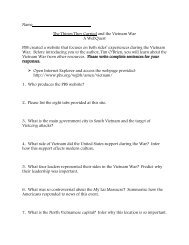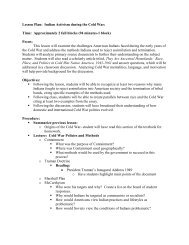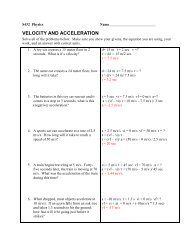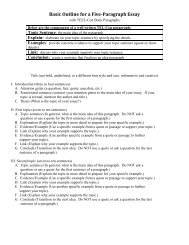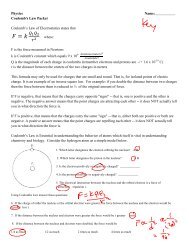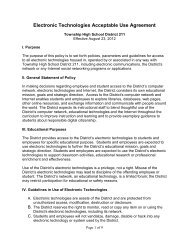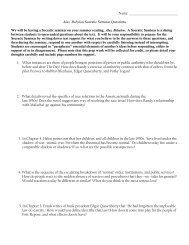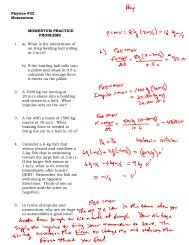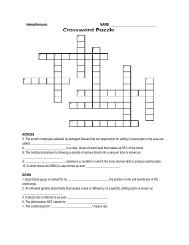1. A bar of length 10 cm slides along metal rails at a speed of 5 m/s ...
1. A bar of length 10 cm slides along metal rails at a speed of 5 m/s ...
1. A bar of length 10 cm slides along metal rails at a speed of 5 m/s ...
Create successful ePaper yourself
Turn your PDF publications into a flip-book with our unique Google optimized e-Paper software.
<strong>1.</strong> A <strong>bar</strong> <strong>of</strong> <strong>length</strong> <strong>10</strong> <strong>cm</strong> <strong>slides</strong> <strong>along</strong> <strong>metal</strong> <strong>rails</strong> <strong>at</strong> a <strong>speed</strong> <strong>of</strong> 5 m/s in amagnetic field <strong>of</strong> 0.1 T. Wh<strong>at</strong> is the motional emf induced in the <strong>bar</strong> and<strong>rails</strong>?2. The rectangular loop shown in Fig. 21-44 is pushed into the magnetic fieldwhich points inward as shown. In wh<strong>at</strong> direction is the induced currentflowing through the resistor R?3. The moving rod in Fig. 21-9 is 12.0 <strong>cm</strong> long and moves with a <strong>speed</strong> <strong>of</strong> 15.0<strong>cm</strong>/s. If the magnetic field is 0.800 T, calcul<strong>at</strong>e (a) the emf developed, and(b) the electric field in the rod.4.
4. In Fig. 21-9, the rod moves with a <strong>speed</strong> <strong>of</strong> <strong>1.</strong>9 m/s, is 30.0 <strong>cm</strong> long, and has aresistance <strong>of</strong> 2.5 Ω. The magnetic field is 0.75 T, and the resistance <strong>of</strong> the U-shaped conductor is 25.0 Ω <strong>at</strong> a given instant. Calcul<strong>at</strong>e (a) the induced emf, (b)the current flowing in the circuit, and (c) the external force necessary to ensureth<strong>at</strong> the rod is moving <strong>at</strong> constant velocity <strong>at</strong> th<strong>at</strong> instant.Once again, let’s just turn 30 <strong>cm</strong> into .3 m to start with.a) We’ll use the equ<strong>at</strong>ion ε=Blv and just plug in all the numbersε = Blv = .75 * .3 * <strong>1.</strong>9 = .4275 = .43 Vb) Gre<strong>at</strong>, current flowing in the circuit. Well, let’s use I=ε/RI = .4275 / (25 + 2.5) = .01554 = .016 Ac) F = IlB = .01554 * .3 * .75 = .003497 = .00355. A single rectangular loop <strong>of</strong> wire with dimensions shown in Fig. 21-49 is situ<strong>at</strong>edso th<strong>at</strong> part is inside a region <strong>of</strong> uniform magnetic field <strong>of</strong> 0.450 T and part isoutside the field. The total resistance <strong>of</strong> the loop is 0.230 Ω. Calcul<strong>at</strong>e the force
equired to pull the loop from the field (to the right) <strong>at</strong> a constant velocity <strong>of</strong> 3.40m/s. Neglect gravity.For this, we’ll start with the equ<strong>at</strong>ion E=Bvl = .45 * 3.4 * .35 = .5355V=IR or .5355 = I * .23, so I = .5355/.23 = 2.328And for the grand finale, F = IlB = 2.328 * .35 * .45 = .366666 = .367 N


